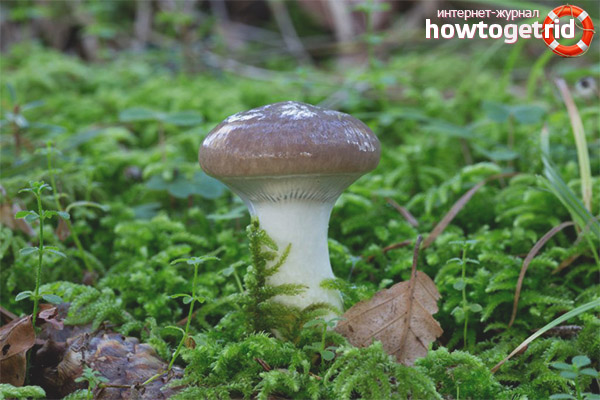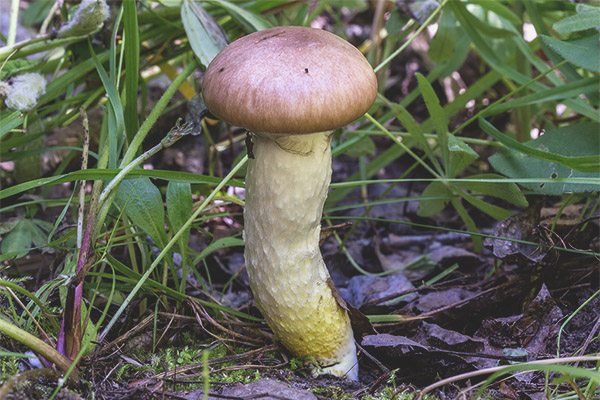The content of the article
In the forests of our country there are several species of such a fungus as mokruha, belonging to the family of lamellar. Although they are lagging behind in their popularity from boletus and butter, nevertheless, the percentage of nutrients in their composition suggests that their nutritional value is much higher than even in white mushrooms.
The most common and desirable for mushroom pickers is such a species as spruce moorhead, which many people call slugs because of the increased mucus content, which almost completely covers the fruit body.
Description of the species
The hat is convex, the edge is wrapped around the leg. With the maturation of the slug, the hat unfolds. In the center there is a small tubercle, directly the surface of the cap is depressed.The secreted mucus on subsequent drying opens the surface, the main color of which is brownish-brownish. With a purple hue at the edges. The cap of adult mushrooms is often decorated with small spots covering the entire skin. The maximum diameter of the cap is 120 mm.
The pulp of a slug is rather soft, but at the same time dense, has a pronounced mushroom aroma and neutral taste. The color of the flesh of young mushrooms is white, in adults it is gray.
The spruce mokruhi lamellar tissue is sparse, branched, white at the beginning of the development of the fungus, with a touch of mucus. Plate adult slugs have a dark color. Spore powder - brown with a characteristic greenish tint.
The leg of a mushroom species like a slug has a thickness of about 2-2.5 cm, it reaches a length of 110 mm. The structure is quite dense with a mucous coating, completely smooth, the color is white, the closer to the base, the yellower the color.
Although the moorie has little attractive appearance, nevertheless, it is quite edible mushroom.
Distribution, especially fruiting
Wet harvesting season begins in mid-summer and lasts until mid-autumn, mostly mushrooms grow in small groups.
Similar species
One of the advantages of this type of mushroom, like mokruha fir, is that it has practically no dangerous, poisonous counterpart. However, a slug is very similar to mock-spotted and purple. Also, a slug has some external similarity with the autumn oiler due to the dark cap covered with a certain amount of mucus. The difference of the species is that the oil can under the cap does not have a lamellar body.
Cooking features

A slug is a rather tasty mushroom, the preparation of which involves a variety of different ways: pickling, stewing, roasting and canning. Fried mokruha adds to most dishes additional harmonious notes, so that their taste becomes more intense and fragrant.Before cooking mokruhu should be thoroughly washed, cleared of stuck foliage and grass. Also a prerequisite for the processing of this type of mushroom is to remove the skin from the cap. After that, the mushrooms are washed again and boiled for 20 minutes. As a rule, after heat treatment, the fruit body of the slug changes its color a little - it becomes dark, which is quite normal and does not affect the taste of the fungus in any way.
Collection advice
There are a few simple rules and recommendations that you should definitely read before you go on the "hunt" for spruce mokruhoy.
- Cutting the fruit body must be done with a mushroom knife; this should be done carefully so as not to damage the mycelium.
- The collection of this type of mushrooms should be carried out in a separate basket, because the slug is able to color the fruit body of other species in purple.
- Older mushrooms are best missed because their fruit body can be wormy.
- It is best to collect spruce moor in the early morning, in which case the fungus will not have time to waste all its moisture, that is, the harvested mushroom harvest will contain a greater number of beneficial trace elements.
- The ideal condition for the growth of mushrooms is warm rain. Do not collect slugs in dry weather.
- Mushrooms are best processed the same day they were harvested. Selected after inspection and cleaning mokruha can be stored in a cool place for later storage. Frozen slugs can be stored for one year.
Medical applications
Especially useful is the use of mokruha for people suffering from such illnesses as constant headaches, diseases of the nervous system, as well as chronic fatigue syndrome. A slug tincture is often used as an effective antimicrobial agent, which is caused by the effective suppression of pathogens and harmful microflora in the human body, including staphylococcal sticks.Mokruhu is also used to heal various wounds and to treat ENT diseases.
It is also important to understand that such a folk remedy has not passed the relevant clinical studies, that is, its effect on the body is not scientifically confirmed.
Video: Mokruha fir (Gomphidius glutinosus)











To send